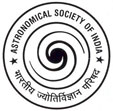August 2018:
The AstroSat Picture of the Month for August 2018 is an X-ray image of the Tycho Supernova Remnant in the 0.8-2.0 nanometres (0.6-1.6 keV) range, made by the Soft X-ray Telescope on board AstroSat. The supernova remnant is roughly 8 arcminutes big (3.7 times smaller than the full moon in the sky) and the emission is brighter near the edge of the expanding supernova remnant.
Pic Credit: Kulinder Pal Singh (IISER Mohali) and the entire SXT Instrument and POC teams at TIFR, University of Leicester, and IUCAA


“AstroSat Picture of the Month” is an initiative of the Public Outreach and Education Committee of the Astronomical Society of India and the AstroSat Training and Outreach Team.
X-raying a Supernova Remnant
This month, for the first time, we bring you an X-ray image from AstroSat. We feature the image of the Tycho Supernova remnant or SN 1572, imaged by the Soft X-ray Telescope (SXT). Located in the constellation Cassiopeia, at a distance of about 10000 light years, SN 1572 is a historic object. It is one of the 8 supernova explosions that were seen with the naked eye. This new star appeared in the sky during early November in 1572, and was observed by many astronomers across Europe and China. It is named after Tycho Brahe since he was the one who studied it in great detail till it faded away in 1574. He published his observations in his work 'Concerning the Star, new and never before seen in the life or memory of anyone', which included a star chart too. At its peak, it rivalled Venus at its brightest, confounded astronomers at that time, and changed their perspective of an unchanging sky.
We now know, from historic data, that this was a Type 1a supernova explosion. Sometimes, a normal star and a white dwarf (which is a very compact object that is the end stage of stars like our Sun) orbit each other. Material from the normal star is pulled on to the white dwarf due to gravity, making it heavier. When the mass of the white dwarf exceeds the famous Chandrasekhar Limit, it explodes, leading to a Type 1a supernova, like our SN 1572. What we see today is what is left of this explosion. The debris is expanding outwards like a sphere, with an edge which is the shock front. This supernova remnant, discovered first in radio wavelengths, and then in optical and X-rays and infrared, is a beautiful object indeed.
X-rays can penetrate metal easily. Hence, the cleverly designed Soft X-ray Telescope uses 320 concentric gold coated mirrors and a very cold CCD to form images in the X-ray. The image of the Tycho Supernova remnant shown here is made from photons with wavelengths between 0.8 to 2.0 nanometres (0.6-1.6 keV). Most of this emission, coming from the limb of the expanding shell, is due to emission from Iron atoms where electrons jump from higher levels to the 2nd level.
The paper can be downloaded here.
Click here for the entire APOM archive.
More about ASTROSAT
AstroSat, India's first dedicated multi-wavelength space observatory, was launched by ISRO on 28 September, 2015. It has five instruments on board – the Ultra Violet Imaging Telescope, the Soft X-ray Telescope, the Large Area X-ray Proportional Counter, the Cadmium-Zinc-Telluride Imager and the Scanning Sky Monitor.
Get answers to your common queries about ASTROSAT in English, in हिंदी, and in मराठी.

